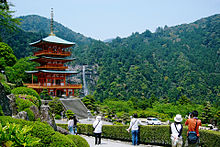Seiganto-ji
The Seiganto-ji ( Japanese 青 岸 渡 寺 ) is a Tendai-shū temple in the Nachi-Katsuura community in the Higashimuro district of Wakayama Prefecture in Japan .
The original construction of the temple dates from the 5th to 7th centuries. The main buildings date from 1590 and were completely restored in 1924. Before 1868 and the then enacted Shinbutsu-Bunri laws, the Seiganto-ji was known as Nyoirinkannon-dō (如意輪 観 音 堂). Up to this point in time, in the course of Shinbutsu-Shūgō, no significant distinction had been made between Buddhist and Shinto shrines in the area.
The Seiganto-ji is located in the immediate vicinity of the sacred waterfall Nachi-no- (Ō) taki (also Ichi-no-taki; at 133 meters the highest waterfall in Japan) and the Kumano Nachi-Taisha and forms with this and the Kumano Hayatama -Taisha , the Kumano Hongū Taisha and Fudarakusan-ji the Kumano Sanzan , the southernmost of the Holy places and pilgrimage Routes in the Kii mountains , by the 2004 UNESCO in the list of world cultural heritage were taken.
The main hall, which Toyotomi Hideyoshi had built in 1590, and the small stone pagoda on the north side of the main hall from 1322 in the Hōkyōin style (宝 篋 印 塔) are registered as an important cultural asset .
Seiganto-ji is the first of the 33 temples on the Saigoku Pilgrimage Route ( 西 国 三十 三 箇 所 , Saigoku sanjūsankasho ), a pilgrimage that was first carried out in 1161.
literature
- Wakayama-ken kotogakko-shakai-ka kenkyu-kyokai (Ed.): Seiganto-ji. In: Wakayama-ken no rekishi sampo. Yamakawa Shuppan, 2009, ISBN 978-4-634-24630-0 , pp. 270, 271.
Web links
- Official Website - Japanese
- Photo gallery - Japanese
Coordinates: 33 ° 40 ′ 10.7 " N , 135 ° 53 ′ 23.6" E
